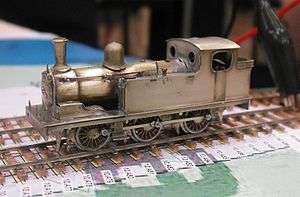2 mm scale
2mm scale, often 2mm finescale is a specification used for railway modelling, largely for modelling British railway prototypes. It uses a scale of 2 mm on the model to 1-foot on the prototype, which scales out to 1:152. The track gauge used to represent prototype standard gauge (4'8½") is 9.42 mm (0.371 in). Track and wheels are closer to dead scale replicas than commercial British N.
| 2 mm finescale | |
|---|---|
 A 2mm scale steam locomotive in unpainted condition | |
| Scale | 2 mm to 1ft |
| Scale ratio | 1:152 |
| Model gauge | 9.42 mm (0.371 in) |
| Prototype gauge | Standard gauge |
| Website | 2mm Association |
The 2mm standards[1] were proposed by Mr. H H Groves in the early 1960s and revised to their current specification in November 1963 by Geoffrey Jones[2]. It is similar in size to the slightly larger British N scale at 1:148 and the slightly smaller European/American N scale at 1:160; though it predates both.
Since 2mm scale is very close to the 1:148 British N scale, a hybrid specification can be modelled by rewheeling proprietary British N scale models to the 9.42 mm track gauge. This hybrid specification results in a track gauge equivalent to 4 feet 6⅞ inches (1394mm), slightly narrower than the prototype 4 feet 8½ inches. There is an advantage however in the narrower gauge as this allows more room for the outside motion of outside cylindered steam locomotives which must be overscale in order to function correctly. This approach is often recommended for beginners. However, 2mm-scale and hybrid-scale models do not usually sit well together due to the larger size of the latter.
Support
No ready-to-run models are available in 2mm scale, and although there is some availability of kits and components, some model-making skill is normally required.
There is an active association, The 2mm Scale Association, for modellers in this scale, who supply components, tools and jigs, publish a bi-monthly magazine, organise local groups, and promote modelling in the scale.
Supplementary Standards
Like Protofour, 2mm standards have been extended to several other prototypes of both wider and narrower gauge with the same tolerances such as Brunel's 7 ft 1⁄4 in (2,140 mm) gauge, Japan Rail's 1,067 mm (3 ft 6 in) narrow gauge and so on.
FiNescale Standard
The FiNescale standard in use for european prototypes is identical to 2mmFS, with the exception of a to-scale rail gauge of 9 mm (0.354 in).
See also
- N scale
- P4 scale
- Proto:87
- ScaleSeven
- Rail transport modelling scales
- Model railway scales
External links
References
- [https://2mm.org.uk/standards.htm 2mm Association Standards
- 2mm Association Magazine November 1963 p7-8